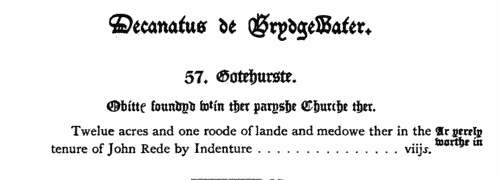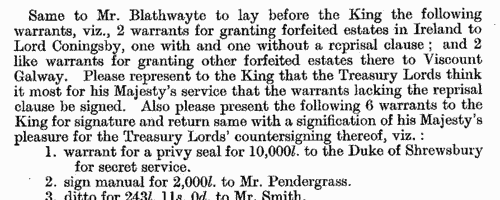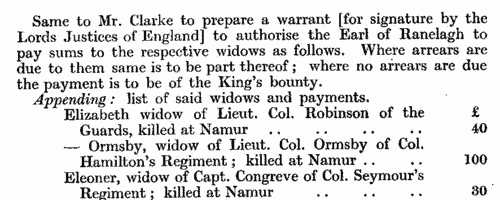Deeds from Bath in Somerset
(1400-1409)
More than 500 mediaeval deeds survived in the muniment chest of Bath in Somerset, almost all dealing with the transfers of small plots of land in the city. Each names the grantor and grantee, describes the land, and is witnessed by other citizens. This printed edition was prepared by the Reverend C. W. Shickle, Master of St John's Hospital in Bath. BARTELOTT. Cost: £4.00.  | Sample scan, click to enlarge

|
Tenants of Somerset chantries
(1548)
Chantries were established to perform services for the souls of their founders and other faithful dead, including annual obits and anniversaries at which alms were usually distributed. The chantries could be at an existing altar in a parish church, a new altar in a side chapel of an existing church, in a new chapel in the churchyard or some miles from an existing church: few were founded before 1300, and most date from 1450 to 1500. Hospitals were places provided by similar foundations to receive the poor and weak; there were also religious guilds, brotherhoods and fraternities, and colleges (like large chantries at which three or more secular priests lived in common). An Act of Parliament of 1545 gave king Henry VIII the power to dissolve such chantries, chapels, &c., the proceeds to be devoted to the expenses of the wars in France and Scotland. Commissioners were appointed 14 February 1546 to survey the chantries and seize their property, and in 1548 the commissioners in Somerset produced this survey and rental. The individuals named are the tenants whose rents provided the chantry's income: occasionally an incumbent is named. The survey was edited by Emanuel Green for the Somerset Record Society, and published in 1888.BARTELOTT. Cost: £4.00.  | Sample scan, click to enlarge

|
Compositions for Knighthood in Sussex: Arundel rape
(1630)
King Charles I 28 January 1630 issued a commission to sit in London and treat with all his subjects who would compound for their fines for not taking up knighthood (a responsibility incumbent on all men of full age having £40 or more a year in land) and for non-attendance to receive their knighthood at his coronation. The returns from the commissioners for Sussex, preserved in the Public Record Office, were edited by sir Henry Ellis and published in 1864. The returns are arranged by rape, the collectors giving the full name of each person paying their composition (usually £10): but more detail is supplied under the returns from the special commission that then certified those persons who had not appeared, refused to pay or excused themselves as being under age or of insufficient means &c. 'notwithstanding they are fitt and able men'. The returns from the special commission specify either the hundred (within the rape) or the parish of residence.BARTELOTT. Cost: £4.00.  | Sample scan, click to enlarge

|
Treasury Books
(1696)
Records of the Treasury administration in Britain, America and the colonies, from April to September 1696. These also include records of the appointment and replacement of customs officers such as tide waiters and surveyors.BARTELOTT. Cost: £4.00.  | Sample scan, click to enlarge

|
Treasury Books
(1697-1698)
Records of the Treasury administration in Britain, America and the colonies, from 1 October 1697 to 31 August 1698. These also include records of the appointment and replacement of customs officers such as tide waiters and surveyors.BARTELOTT. Cost: £4.00.  | Sample scan, click to enlarge

|
 Masters of apprentices registered in Winchester
(1769) Masters of apprentices registered in Winchester
(1769)
Apprenticeship indentures and clerks' articles were subject to a 6d or 12d per pound stamp duty: the registers of the payments usually give the master's trade, address, and occupation, and the apprentice's name, as well as details of the date and length of the apprenticeship. There are central registers for collections of the stamp duty in London, as well as returns from collectors in the provinces. These collectors generally received duty just from their own county, but sometimes from further afield. The indentures themselves can date from a year or two earlier than this return. (The sample entry shown on this scan is taken from a Durham return. Each entry has two scans, the other being the facing page with the details of the indenture, length of service, and payment of duty.) IR 1/57BARTELOTT. Cost: £8.00.  | Sample scan, click to enlarge

|
 Masters of Apprentices registered in Hampshire
(1776) Masters of Apprentices registered in Hampshire
(1776)
Apprenticeship indentures and clerks' articles were subject to a 6d or 12d per pound stamp duty: the registers of the payments usually give the master's trade, address, and occupation, and the apprentice's name, as well as details of the date and length of the apprenticeship. There are central registers for collections of the stamp duty in London, as well as returns from collectors in the provinces. These collectors generally received duty just from their own county, but sometimes from further afield. The indentures themselves can date from a year or two earlier than this return. (The sample entry shown on this scan is taken from a Bristol return. Each entry has two scans, the other being the facing page with the details of the indenture, length of service, and payment of duty.) IR 1/60BARTELOTT. Cost: £8.00.  | Sample scan, click to enlarge

|
Bankrupts
(1837)
Bankruptcy notices for England and Wales: bankruptcy often caused people to restart their lives elsewhere, so these are an important source for lost links
BARTELOTT. Cost: £6.00.  | Sample scan, click to enlarge

|
Bankrupts
(1838)
Bankruptcy notices for England and Wales: bankruptcy often caused people to restart their lives elsewhere, so these are an important source for lost links
BARTELOTT. Cost: £6.00.  | Sample scan, click to enlarge

|
Insolvents
(1843)
Insolvency notices for England and Wales: insolvency often caused people to restart their lives elsewhere, so these are an important source for lost linksBARTELOTT. Cost: £6.00.  | Sample scan, click to enlarge

|
Research your ancestry, family history, genealogy and one-name study by direct access to original records and archives indexed by surname.













